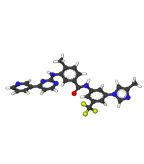Nilotinib-Resistant CML Cells Show Abnormal Expression of Several Genes, Suggests Therapeutic Targets
The second generation tyrosine kinase inhibitor nilotinib (Tasigna, Novartis) has proven to be an effective treatment for imatinib-resistant patients with chronic myeloid leukemia (CML). Just as with imatinib, however, some resistance has been observed.
The second generation tyrosine kinase inhibitor nilotinib (Tasigna) has proven to be an effective treatment for imatinib-resistant patients with chronic myeloid leukemia (CML). Just as with imatinib, however, some resistance has been observed. A research group in Turkey found a number of potential specific mechanisms for nilotinib resistance, including upregulation of BCR/ABL, GCS, and SK-1 genes, among others.

Ball-and-stick model of nilotinib
“CML was the first neoplasm associated with a chromosomal translocation, known as the Philadelphia chromosome,” wrote researchers led by Aylin Camgoz of the Izmir Institute of Technology in Izmir, Turkey, in the journal Leukemia and Lymphoma. Imatinib is effective in many CML cases, but resistance is fairly common; about 25% to 30% of patients will discontinue imatinib within 5 years because of lack of response, resistance, or toxicity. According to the prescribing information, nilotinib can yield a major cytogenetic response in 51% of patients who are resistant or intolerant to imatinib.
In this study, the researchers examined nilotinib resistance mechanisms using K562/NIL-50 CML cells along with parental sensitive counterparts (K562 cells). As previously established, the resistant cells had substantially higher expression levels of BCR/ABL than the parental sensitive cells; the resistant cells had a 3.85-fold higher level of BCR/ABL expression than the sensitive cells. “The main mechanism responsible for the development of resistance in CML is the point mutations that prevents the binding of the inhibitors,” the authors wrote.
The resistant cells showed significant increases in several genes that can limit apoptosis. There was a 2.45-fold increase in expression of the ceramide-metabolizing GCS gene compared with the nilotinib-sensitive cells, and a 2.04-fold increase in expression of the SK-1 gene. Inhibition of GCS and SK-1 along with increasing concentrations of nilotinib appeared to overcome resistance to the drug, suggesting that these could represent a therapeutic target for future drugs.
More generally, nilotinib resistance can likely be explained, the authors wrote, by a failure to induce apoptosis. The researchers examined other genes that are known to regulate such programmed cell death, including BCL2, BCL-XL, caspase 3, and BAX. They found a 25% decrease in expression of the BAX gene in the K562/NIL-50 cells compared to parental counterpart cells, though the other genes were not significantly different between the cell lines.
Nilotinib is currently under investigation for use as a first-line therapy for CML in the ENEST1st trial.